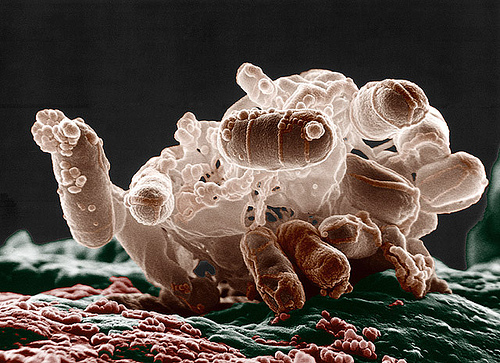 E. coliPhoto: Microbe WorldAbout a month ago, Food Safety News broke the story that the government was on the verge of action on a much-delayed rule to make several toxic forms of E. coli illegal in meat. And today, the USDA, in particular the director of its Food Safety and Inspection Service (FSIS) Dr. Elizabeth Hagan, came through.
E. coliPhoto: Microbe WorldAbout a month ago, Food Safety News broke the story that the government was on the verge of action on a much-delayed rule to make several toxic forms of E. coli illegal in meat. And today, the USDA, in particular the director of its Food Safety and Inspection Service (FSIS) Dr. Elizabeth Hagan, came through.
You heard that right. Before today, the only form of E. coli that had been banned was H7:O157 — the strain behind the infamous Jack in the Box outbreak of 1994. There are several other highly toxic forms of E. coli that appear in food, however, including a set of pathogenic Shiga toxin-producing E. coli strains known as the “Big Six.” Despite the fact that, as Food Safety News reported in August, the Big Six “cause almost 40,000 illnesses, 1,100 hospitalizations, and 30 deaths annually,” it has taken until now for the USDA to make this change.
From The New York Times:
Federal food safety officials said on Monday that they would ban the sale of ground beef containing six toxic strains of E. coli bacteria that have increasingly been showing up in the food supply, taking a long-delayed step that was opposed by many in the meat industry.
“This is one of the biggest steps forward in the protection of the beef supply in some time,” said Dr. Elisabeth Hagen, the head of food safety for the Department of Agriculture, which regulates meat. “We’re doing this to prevent illness and to save lives.”
The meat industry is predictably nonplussed — they have been unabashedly and stridently fighting the Big Six rule change for the last several years. According to The New York Times, the American Meat Institute, an industry group, released a statement saying:
“Imposing this new regulatory program on ground beef will cost tens of millions of federal and industry dollars — costs that likely will be borne by taxpayers and consumers. It is neither likely to yield a significant public health benefit nor is it good public policy.”
I imagine the 40,000 people sickened and the 30 families who have experienced tragic loss from the Big Six in any given year might beg to differ. It’s also worth noting that aggregate costs such as the AMI cites are highly misleading. Given the amount of meat sold nationwide, the new testing is likely to add pennies per pound, if that, to the cost in the supermarket.
In fact, FSN says some experts have speculated that the controls industry has already put in place against O157 will likely be equally effective against the other members of the Big Six, which suggests the costs to industry might be quite modest. Sadly, it’s hard not to conclude that the meat industry would rather wait for another watershed outbreak, such as the one that occurred in 1994 (which pushed the USDA to declare O157 illegal), than take the proactive stance the public health community has been demanding for years.
Of course, the fight against pathogens is far from over. The toxic form of E. coli that caused the recent German sprouts outbreak wasn’t on public health experts’ radar before it happened. And the Salmonella strain behind the recent massive recall of ground turkey is also still legal in meat. Even so, it’s nice to know that “people-killing” pathogens take precedence over supposed “job-killing” regulations at the USDA. FSIS Chief Hagan deserves our thanks.



